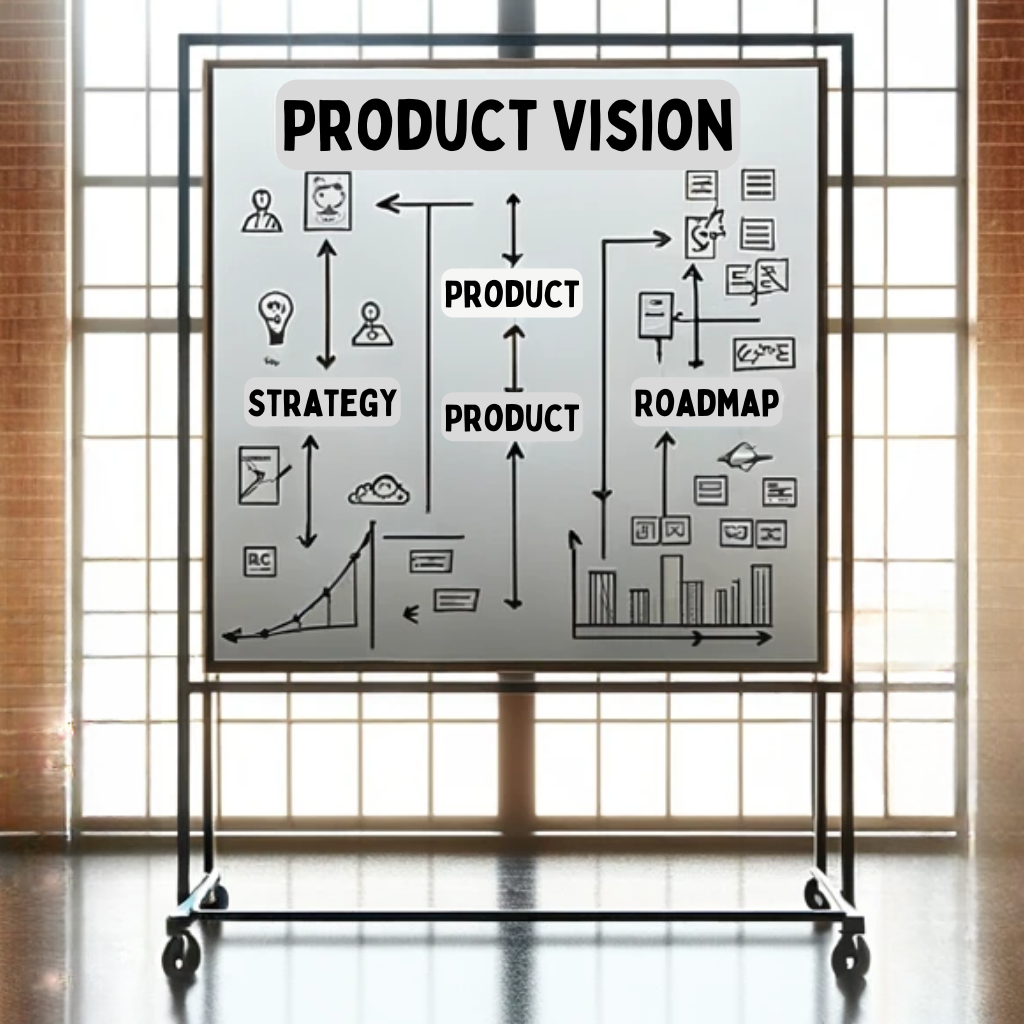Introduction
Navigating the jungle from idea inception to market success can be challenging. Central to this journey are three pillars: Product Vision, Product Strategy, and Product Roadmap. Each serves a unique purpose, yet they are intrinsically linked, forming the backbone of effective product management. This blog post delves deep into these crucial components, elucidating their definitions, business impacts, and the symbiotic relationships amongst them. Whether you’re a CEO, Product Manager, or someone new to the realm of product development, understanding these elements is key to ensuring your product not only survives but thrives in the competitive market landscape. If you want to know about what product management is, then read this.
Product Vision
What is a Product Vision?
A Product Vision is a forward-looking statement that encapsulates the overarching goal or aspiration for a product. It paints a vivid picture of what the product aspires to achieve in the long run, serving as the guiding star for all product-related decisions.
The significance of a clear product vision
A clear Product Vision is essential as it acts as the foundation for the entire product development process. It ensures that all stakeholders have a shared understanding of what the product aims to achieve, fostering cohesion and alignment throughout the product’s lifecycle.
Impact on Business
Guiding the company’s direction
A well-articulated Product Vision provides direction not just for the product team but for the entire organization. It helps in setting clear expectations, shaping strategic decisions, and informing the roadmap.
Ensuring alignment with business goals and values
The Product Vision ensures that the product’s trajectory is in sync with the company’s broader objectives and values. This alignment ensures that the product not only meets market demands but also resonates with the company’s ethos and brand identity.
Why Do We Need A Product Vision?
Driving innovation and differentiation
In today’s competitive market, a unique Product Vision can be the differentiating factor that sets a product apart. It encourages teams to think innovatively, striving to realize a vision that distinguishes the product from its competitors.
Providing clarity and inspiration to teams
A compelling Product Vision acts as a source of inspiration for teams, motivating them to bring their best to the table. It provides clarity by setting a defined path, helping teams understand their roles in the larger picture and the impact of their contributions.
Key Components Of A Product Vision
Long-term perspective
A robust Product Vision is not about immediate gains but looks several years into the future. It’s about where the product aspires to be in the long run, considering evolving market trends and customer needs.
Alignment with company mission
For a Product Vision to be effective, it must resonate with the company’s mission. This alignment ensures that the product becomes an integral part of the company’s growth story, reinforcing its core values and objectives.
Customer and market focus
An impactful Product Vision is rooted in a deep understanding of the customer and the market. It anticipates future needs, preferences, and challenges, ensuring that the product remains relevant and valuable to its target audience.

Product Strategy
What is a Product Strategy?
A Product Strategy is a systematic plan that outlines how a product will achieve its objectives and deliver value to its users while aligning with the broader business goals. It serves as a roadmap, guiding product decisions based on market conditions, customer feedback, and internal constraints and capabilities on a high-level.
The role of strategy in product development
In the realm of product development, strategy acts as the bridge between the overarching vision and the tangible actions needed to bring it to fruition. It ensures that every decision, from feature prioritization to design choices, is made with a clear purpose and direction in mind.
Impact on Business
Aligning product development with business objectives
Product Strategy ensures that the development process aligns seamlessly with the company’s larger objectives. By providing a clear framework, it guarantees that the product evolves in a manner conducive to achieving business goals, be it market expansion, revenue growth, or brand enhancement.
Ensuring competitive advantage and market positioning
A well-thought-out Product Strategy helps a business carve out a distinct position in the market. By identifying unique value propositions and differentiators, it ensures that the product stands out in a crowded marketplace, securing a competitive advantage.
Why Is A Product Strategy Needed?
Prioritizing features and initiatives
With limited resources and time, businesses can’t pursue every opportunity or implement every feature. A robust Product Strategy aids in prioritizing initiatives, ensuring that efforts are channeled towards the most impactful and relevant features.
Addressing market changes and customer needs effectively
Markets are dynamic, and customer preferences evolve. A flexible Product Strategy equips businesses to adapt swiftly, recalibrating their approach to address emerging challenges and capitalize on new opportunities.
Elements of an Effective Product Strategy
Clear objectives and key results (OKRs)
At the heart of any effective strategy are clear objectives. Using OKRs, businesses can set specific, measurable goals for the product, ensuring that teams have a clear understanding of what success looks like.
Understanding of target audience and market dynamics
A deep understanding of the target audience, their pain points, and preferences is crucial. Coupled with insights into market trends and competitor activities, this knowledge ensures the product remains aligned with user needs and market realities.
Risk assessment and mitigation
Every product journey comes with its set of risks, be it technological challenges, market uncertainties, or competitive threats. A comprehensive Product Strategy assesses these risks upfront and devises mitigation plans, ensuring that potential hurdles are addressed proactively.
Product Roadmap
What is a Product Roadmap?
A Product Roadmap is a visual representation that outlines the planned development path of a product over time. It captures the sequence of enhancements, features, and major milestones, providing a high-level view of the product’s evolution and the strategic direction it intends to take.
The evolution of roadmaps in product management
Historically, roadmaps were rigid, long-term plans that were infrequently updated. However, with the rise of agile methodologies and the fast-paced nature of modern markets, roadmaps have evolved into dynamic tools. They now prioritize adaptability, allowing product teams to respond swiftly to feedback and changing market conditions.
Business Impact
Visual representation of product’s journey
The Product Roadmap offers stakeholders a bird’s-eye view of the product’s trajectory. By visualizing the planned initiatives and their interdependencies, it provides clarity on the product’s current state and its future direction.
Facilitating stakeholder communication and buy-in
Roadmaps serve as an invaluable communication tool. They align internal teams, ensuring everyone is on the same page. Moreover, they aid in garnering support and buy-in from external stakeholders, including investors, partners, and customers, by showcasing the product’s vision and strategy.
Why Do We Need A Product Roadmap?
Prioritizing and scheduling product features
With a myriad of potential features and improvements vying for attention, the roadmap assists product managers in prioritizing what to build next. It helps determine which features will deliver the most value and when they should be introduced.
Setting clear expectations and managing resources
By laying out a clear plan, the roadmap sets expectations for various stakeholders, from developers to marketers. It aids in resource allocation, ensuring that teams have the necessary assets and time to execute on the outlined initiatives.
Features of a Comprehensive Product Roadmap
Timeframes and milestones
A well-structured roadmap includes specific timeframes, be it weeks, months, or quarters. These timeframes are punctuated with key milestones, marking significant achievements or phases in the product’s lifecycle.
Clear categorization of tasks
Tasks on the roadmap are clearly categorized, whether they pertain to new features, enhancements, or bug fixes. This clear demarcation aids in understanding the nature and priority of each task.
Flexibility and adaptability to changes
In today’s dynamic market landscape, adaptability is key. Modern roadmaps are designed with flexibility in mind, allowing for adjustments based on feedback, unforeseen challenges, or shifts in strategy.
Product management is often likened to a journey. If that’s the case, then the Product Vision, Strategy, and Roadmap are akin to the destination, the route, and the travel plan, respectively. Each of these elements is distinct, yet they are interwoven in a manner that drives the product towards success.
The Interplay Between Vision, Strategy, and Roadmap
How each component informs the other
- Product Vision sets the overarching goal, the north star. It embodies the long-term ambition and the impact the product aims to make. Once the vision is clear, it paves the way for the strategy.
- Product Strategy delineates the path to achieve the vision. It outlines the major steps, decisions, and priorities necessary to make the vision a reality. It considers market dynamics, customer needs, and competitive landscapes.
- Product Roadmap is the tactical execution of the strategy. It’s a timeline of actions, initiatives, and milestones that will be undertaken to implement the strategy and inch closer to the vision.
The cyclical nature of revisiting and refining these elements
The relationship between the vision, strategy, and roadmap is not linear but cyclical. As the product develops and the market evolves, it’s crucial to revisit and recalibrate these components. Feedback loops, market shifts, or technological advancements might necessitate adjustments. By periodically reviewing and refining the vision, strategy, and roadmap, businesses ensure they remain aligned with their goals and responsive to the ever-changing landscape.
Conclusion
The realms of Product Vision, Strategy, and Roadmap are pivotal in the product management ecosystem. Together, they provide the clarity, direction, and actionable steps required to navigate the complex journey of product development.
The critical role of Product Vision, Strategy, and Roadmap in successful product management:
These elements are not mere documentation or processes; they are the lifeblood of successful product management. The vision inspires, the strategy guides, and the roadmap operationalizes. When these components are robust and aligned, they empower teams to build products that resonate with users and stand out in the marketplace.
Encouraging businesses to invest time and resources in developing these components:
For businesses striving for product excellence, it’s imperative to invest ample time and resources into cultivating a clear vision, devising a sound strategy, and crafting a comprehensive roadmap. This investment not only propels the product forward but also fortifies its foundation, ensuring it’s equipped to adapt, innovate, and thrive in the face of challenges.
In sum, the synergy between Product Vision, Strategy, and Roadmap is the bedrock of successful product management. It’s the compass, the map, and the itinerary that guide the product’s journey from inception to fruition.
FAQ
What is Product Vision?
Product Vision is the overarching aspiration or goal for a product, painting a picture of what the product aims to achieve or become in the long run. It provides a clear direction and serves as a guiding light for all product-related endeavors, ensuring that efforts are channeled towards a unified purpose.
What is Product Strategy?
Product Strategy is the roadmap to achieve the product vision. It’s the plan that outlines how the product will meet the needs of its target audience, address market dynamics, and stand out in the competitive landscape. This strategy typically encompasses decisions about target markets, key features, value propositions, and how the product will evolve over time.
What is a Product Roadmap?
A Product Roadmap is a visual representation detailing the planned development of a product over time. It showcases the prioritized features, enhancements, and tasks set against specific timelines or stages. The roadmap serves as a communication tool between product managers, development teams, stakeholders, and even customers, ensuring everyone is aligned on the product’s direction and progress.
What is the difference between Product Vision and Product Strategy?
Product Vision is the long-term goal or aspiration for what you want the product to achieve or become in the future. Product Strategy, on the other hand, is the plan or approach detailing how you will achieve that vision, considering factors like market dynamics, customer needs, and competitive landscapes.
Why is alignment between Vision, Strategy, and Roadmap crucial?
Alignment ensures that all product-related activities and decisions are directed towards a common goal. It ensures that the overarching vision is translated into strategic plans, which are then operationalized through a detailed roadmap. Misalignment can lead to wasted resources, team confusion, and a product that doesn’t resonate with its target audience.
Can a Product Vision change over time?
Absolutely. While a Product Vision is meant to be a long-term aspiration, it’s not set in stone. As markets evolve, customer preferences shift, and business priorities change, it might be necessary to revisit and adjust the vision to stay relevant and impactful.



